Physical Address
304 North Cardinal St.
Dorchester Center, MA 02124
Even relatively minor chest wall injuries, such as rib fractures, may result in serious complications in elderly patients and patients with preexisting pulmonary disease if adequate analgesia and close follow-up care are not provided.
Unless there are abnormalities on the electrocardiogram (ECG) or an elevated serum troponin level, there is no need to pursue the diagnosis of myocardial contusion with more sophisticated testing.
Many patients with myocardial rupture or traumatic aortic rupture survive to reach the hospital and can be salvaged with rapid diagnosis and intervention.
Pericardial tamponade can be diagnosed accurately before hemodynamic decompensation occurs by standard cardiac ultrasound performed by emergency clinicians.
Chest computed tomography (CT) scan is the diagnostic test of choice for blunt aortic injury even in the presence of normal chest radiographs.
The NEXUS-Chest CT criteria can be used to determine the need for chest CT in patients with blunt trauma.
Many causes of early deaths (within the first 30 to 180 minutes) resulting from thoracic trauma are preventable and include tension pneumothorax, cardiac tamponade, airway obstruction, and uncontrolled hemorrhage.
Approximately 75% of patients with thoracic trauma require only simple tube thoracostomy and volume resuscitation, and the initial care and disposition of these patients is usually performed by emergency clinicians. Care of severe thoracic trauma is multidisciplinary in nature, involving trauma surgeons, cardiothoracic surgeons, and intensivists. Improved understanding of underlying physiologic mechanisms, newer imaging modalities, minimally invasive approaches, and pharmacologic therapies have contributed to decreasing morbidity and mortality in patients with thoracic injuries.
Injury location and type dictates both assessment and management. This chapter is organized into sections highlighting chest wall, pulmonary, tracheobronchial, diaphragmatic, cardiovascular, and esophageal injuries.
The susceptibility to rib fracture increases with age. These injuries can be exquisitely painful, but their importance lies not in the fracture itself, which generally is self-limiting and will heal, but rather with associated complications, particularly pneumothorax, hemothorax, pulmonary contusions, and post-traumatic pneumonia. Rib fractures in children are discussed in Chapter 160 .
An intact chest wall, protected by its rib cage, is necessary for normal ventilation. Outward expansion of the thorax by the respiratory muscles with descent of the diaphragm creates negative intrathoracic pressure. This allows passive air entry into the lungs during inspiration. Chest trauma, particularly blunt trauma, can severely disturb the physiology of respiration. Fortunately, most individuals have substantial respiratory reserve and can tolerate chest wall injuries with adequate support.
Flail chest results when three or more adjacent ribs are fractured at two points, allowing a free segment of the chest wall to move in paradoxical motion ( Fig. 37.1 ), with the flail segment moving inward with inspiration and outward with expiration. It can also occur with costochondral separation or vertical sternal fracture in combination with rib fractures. Underlying pulmonary contusion is considered to be the major cause of respiratory insufficiency with flail chest, and it is therefore one of the most serious chest wall injuries ( Fig. 37.2 ). In addition, flail chest can be associated with a variety of other injuries, including hemopneumothorax, liver or spleen lacerations, and mediastinal injury.
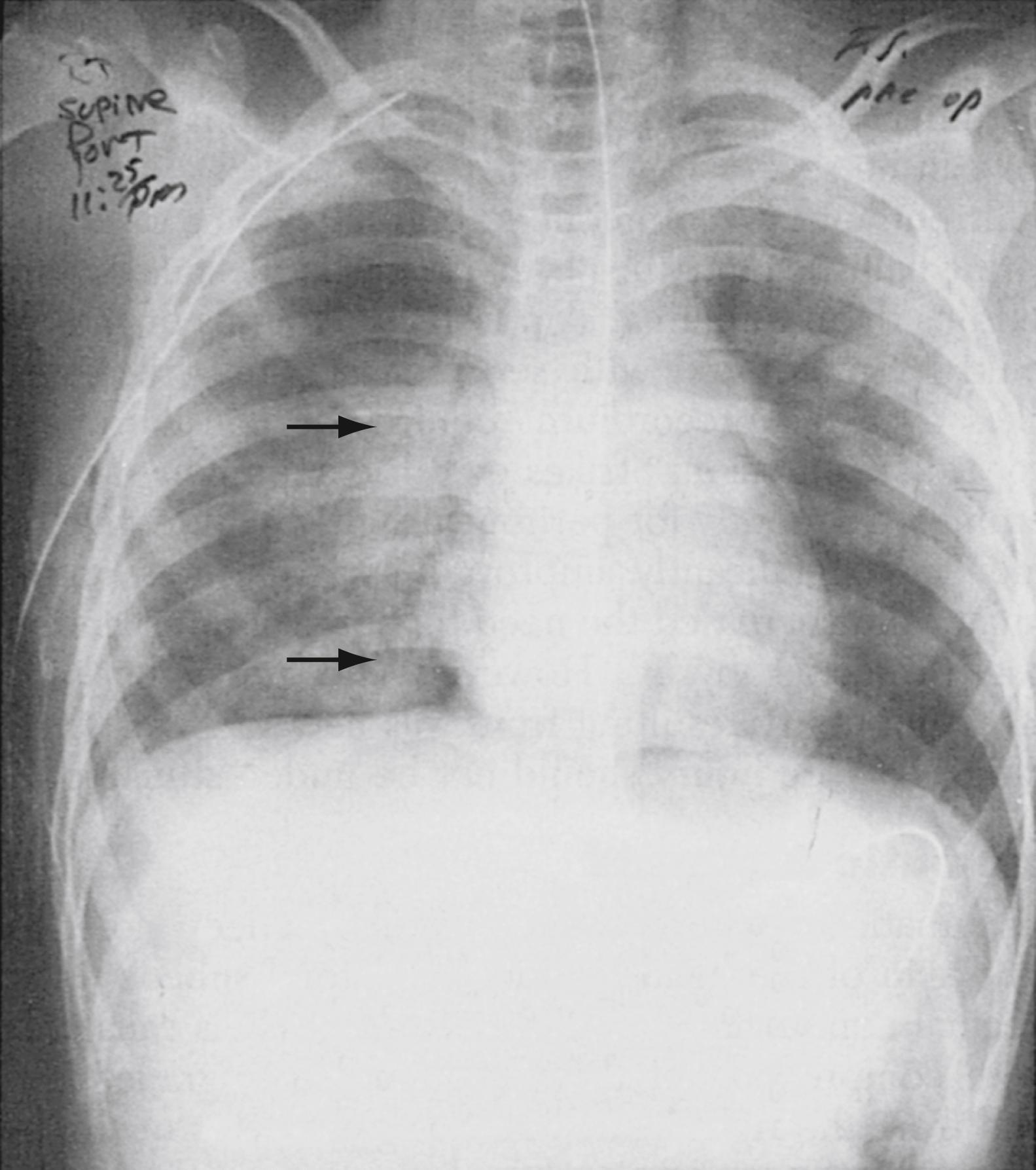
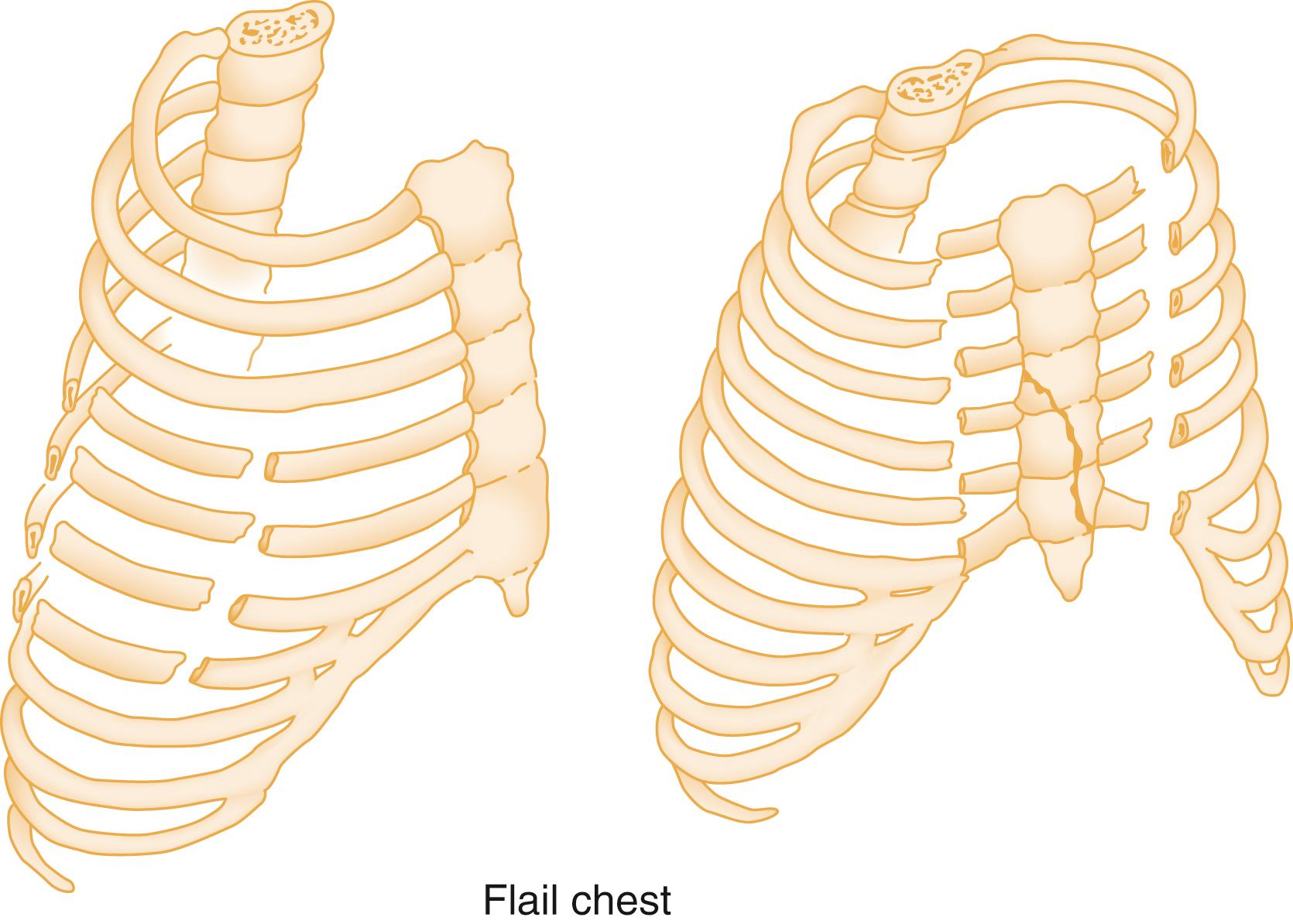
Ribs usually break at the point of impact or at the posterior angle or posterolateral area, which is structurally the weakest area. Ribs 4 to 9 are the most commonly involved. Ribs 1 to 3 are short and relatively protected, and ribs 9 to 12 are longer and more mobile at the anterior end. This confers the relative resistance to fracture of the “high” and “low” ribs. Fractures occur more easily in older adults than younger adults or in children, due to the progressive inelasticity of the chest wall that develops through aging.
The true danger of rib fracture involves not the rib itself but the potential for penetrating injury to the pleura, lung, liver, or spleen. Fractures of ribs 9 to 11 are also associated with intra-abdominal injury. Right-sided rib fractures are associated with hepatic injury and left-sided rib fractures with splenic injury. Injury severity is indicated by the number of rib fractures. The presence of two or more rib fractures at any level is associated with a higher incidence of internal injuries than with a single, isolated fracture. Patients over 65 years old with multiple rib fractures have a greater incidence of pneumonia and a higher mortality compared their younger counterparts.
Rib fracture is often a clinical diagnosis, with severe point tenderness, bony crepitus, ecchymosis, and muscle spasm over the rib being the most common findings. Also, bimanual compression of the thoracic cage remote from the site of injury (barrel compression test) usually produces pain at the site of fracture. Injury to the parenchyma may be detected by assessing the respiratory rate, oxyhemoglobin saturation, respiratory effort, effectiveness of ventilation, and pulmonary breath sounds.
Flail chest is characterized by paradoxical motion of a portion of the chest wall during respiration and is usually obvious on physical examination. Unless the patient is unconscious, there will be severe pain, splinting, tenderness, and crepitus. Paradoxical chest wall motion is a product of negative intrathoracic pressure and is obscured if the patient has been intubated or is receiving positive-pressure ventilation. For such patients, the diagnosis is usually evident on examination of the integrity of the chest wall (compression and crepitus).
Patients with suspected rib fracture have always sustained trauma, thus focusing the evaluation. Patients with significant, potentially multisystem trauma require a thorough trauma evaluation (see Chapter 32 ). Rib fracture, costochondral separation, and rib contusion may present in similar fashion, and it is not critical to identify a single, isolated rib fracture. Patients with multiple suspected fractures are at higher risk for intrathoracic injury and also for later decompensation and complications. Important diagnoses to consider include chest wall or clavicle fracture (especially sternal fracture), pulmonary injuries (pulmonary contusion, laceration, pneumothorax, or hemothorax), tracheobronchial injury, diaphragmatic injury, cardiovascular injury (cardiac contusion or aortic injury), or esophageal injury. These broad differential diagnoses hold true for most patients with thoracic trauma, given the close proximity of the organs involved and the similar mechanisms behind most of the injuries described in this chapter.
Many patients with relatively minor thoracic trauma are evaluated and managed exclusively based on physical findings, and they do not require imaging. When the injury is significant enough to raise concern for underlying pulmonary injury, imaging is required. Because rib fractures are managed expectantly, imaging should be reserved for patients in whom multiple rib fractures, underlying pulmonary injury, or comorbid pulmonary status (e.g., chronic obstructive pulmonary disease [COPD]) is a concern. A plain chest radiograph will identify only about 50% of single-rib fractures; its greatest value is in identifying or excluding significant intrathoracic and mediastinal injuries. Rib series and expiratory, oblique, and cone-down views should not be used routinely. If additional imaging is required beyond a standard upright posteroanterior and lateral chest x-ray, a computed tomography (CT) scan of the chest should be obtained ( Fig. 37.3 ). A CT scan is not indicated to confirm suspected isolated rib fracture, but it will identify multiple-level fractures and associated pulmonary injury, such as pneumothorax or hemothorax, with much greater accuracy than additional chest x-ray views.
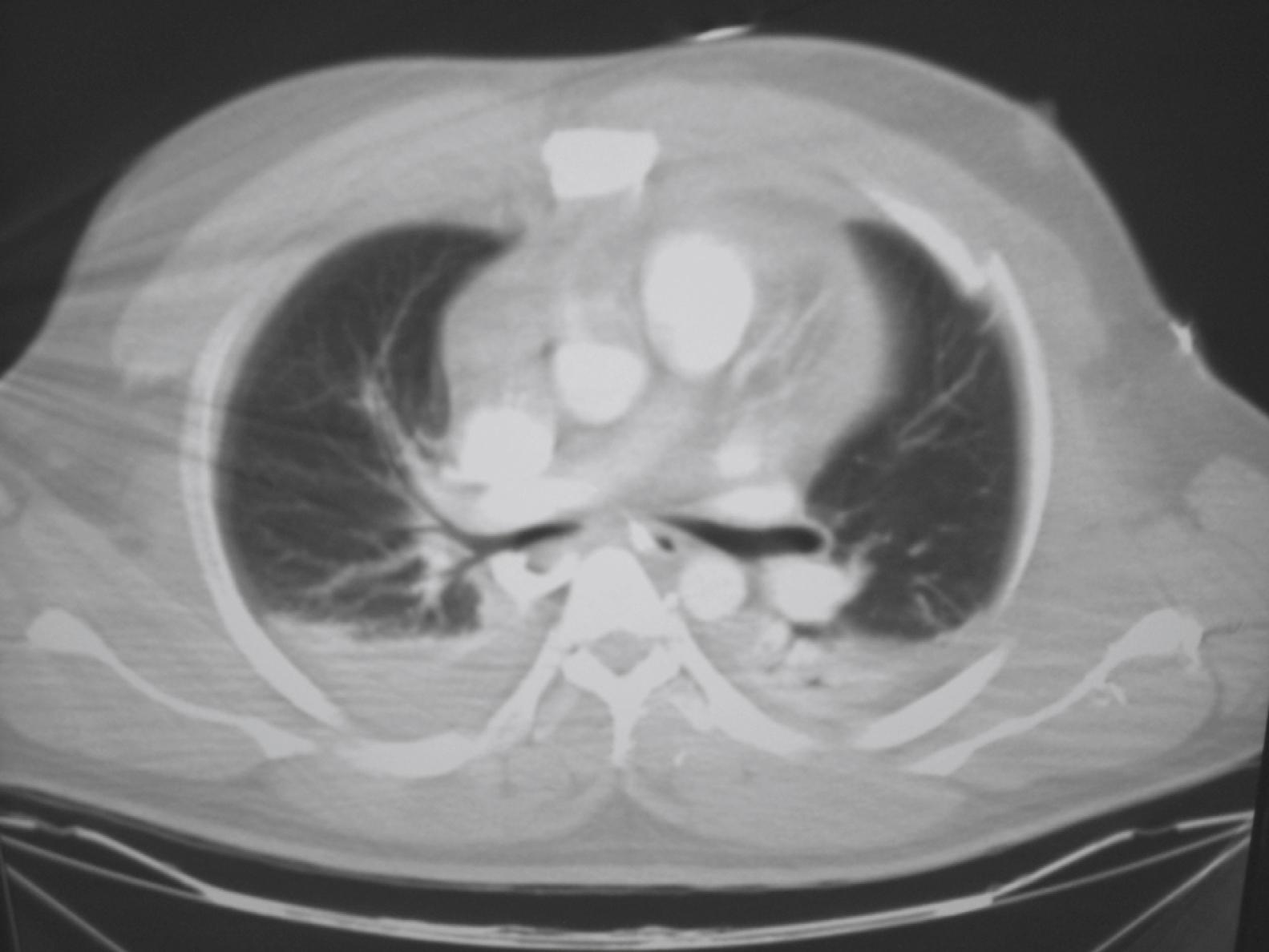
In an attempt to limit unnecessary use of diagnostic ionizing radiation, the National Emergency X-Radiography Utilization Study (NEXUS) group derived and validated a decision instrument to guide the use of chest CT in patients with blunt trauma. The NEXUS-Chest CT derivation and validation studies, performed at eight trauma centers in the United States, enrolled 11,477 patients. In the validation phase, the decision instrument had a sensitivity of 95.4%, a negative predictive value of 93.9%, and a specificity of 25.5% for all thoracic injuries. The results were even more impressive for major clinical injuries, with both sensitivity and negative predictive value approaching 100% (99.2% and 99.8%, respectively). We recommend that CT scan not be obtained for patients sustaining blunt trauma who do not meet any of the seven NEXUS-Chest CT criteria ( Box 37.1 ).
Abnormal chest x-ray
Rapid deceleration mechanism (defined as fall >20 feet or motor vehicle collision >40 mph)
Distracting painful injury
Chest wall tenderness
Sternal tenderness
Thoracic spine tenderness
Scapular tenderness
Respiratory decompensation is the primary indication for endotracheal intubation and mechanical ventilation for patients with multiple rib fractures. Obvious problems, such as hemopneumothorax or severe pain, should be corrected before intubation and ventilation are presumed necessary. In the awake and cooperative patient, noninvasive continuous positive airway pressure (CPAP) by mask may obviate the need for intubation. In general, the most conservative methods for maintaining adequate oxygenation and preventing complications should be used. Adequate analgesia is of paramount importance in patient recovery and may contribute to the return of normal respiratory mechanics.
Treatment of acute rib fractures is based on adequate pain relief and the maintenance of pulmonary function. Outdated management techniques involving stabilization of the flail segment by positioning the person with the injured side down or placing sandbags on the affected segments have been discredited. These interventions actually inhibit expansion of the chest and produce increased atelectasis of the injured lung. Instead, oxygen should be administered, cardiac and oximetry monitors applied, and the patient observed for signs of an associated injury, such as tension pneumothorax.
Otherwise well patients with single rib fractures are managed with opioid and non-opioid analgesia. These injuries can be severely painful, and regular opioid medication along with transdermal lidocaine patches (particularly at bedtime) is usually necessary for up to a week. Thereafter, simple analgesia with acetaminophen or a nonsteroidal anti-inflammatory analgesic generally will suffice. Continuing daily activities and deep breathing should be stressed to ensure ventilation and prevent atelectasis. It is helpful to advise patients to wait 30 to 45 minutes after taking their pain medications before performing deep breathing exercises, ideally with an incentive spirometer.
The greater the number of fractured ribs, the higher the mortality and morbidity rates. Hospitalization should be considered for patients with three or more fractured ribs, despite the lack of other identified injuries, to receive pulmonary therapy, repeated evaluation, and appropriate effective analgesia. Elderly patients with six or more fractured ribs should be treated in an intensive care unit owing to high morbidity and mortality.
Multiple rib fractures in trauma patients are associated with significant morbidity and mortality. Intercostal nerve blocks with a long-acting anesthetic, such as bupivacaine with epinephrine, may relieve symptoms up to 12 hours. Other alternatives for hospitalized patients include patient-controlled analgesia, parenteral opioids, and thoracic epidural analgesia.
For flail segments, consultation with a trauma or thoracic surgeon is essential to plan for surgical intervention. Early operative internal fixation of the flail segment results in a speedier recovery, decreased complications, and better cosmetic and functional results, and it is cost-effective. Indications for open fixation for flail chest include patients who are unable to be weaned from the ventilator secondary to the mechanics of flail chest, persistent pain, severe chest wall instability, or a progressive decline in pulmonary function.
The patient with flail chest should be treated in the emergency department (ED) as if pulmonary contusion exists regardless of whether mechanical ventilation is used.
Most rib fractures heal uneventfully within 3 to 6 weeks, and patients should expect a gradual decrease in their discomfort during this period. However, in addition to the complications of hemopneumothorax, atelectasis, pulmonary contusion, and pneumonia, rib fractures can result in post-traumatic neuroma, empyema, nonunion, or costochondral separation. These rare complications are painful and heal slowly. Patients with blunt trauma and multiple rib fractures should be observed for 12 to 24 hours to ensure that occult vascular or intrapulmonary injuries are not present and then considered for discharge, with the full understanding that the rib fractures themselves will require a prolonged recovery period and close outpatient follow-up.
The outcome of flail chest is a function of associated injuries. Because many different physiologic mechanisms have been implicated in flail chest, there is no consensus about hospital treatment. The cornerstones of therapy include pulmonary physiotherapy, effective analgesia, selective use of endotracheal intubation and mechanical ventilation, and close observation for respiratory compromise.
Sternal fractures and dislocations are caused primarily by anterior blunt chest trauma (e.g., motor vehicle collisions [MVCs] or bicycle accidents when the chest strikes the steering wheel or handlebars). Risk factors for sternal fracture from blunt trauma include types of vehicular passenger restraint systems and patient age. Restrained passengers are more likely than unrestrained passengers to sustain sternal fracture, likely related to the central location of the shoulder portion of the restraint. Cardiac complications, such as myocardial contusion, occur rarely, and there is no association between sternal fracture and aortic rupture. Although sternal fractures may occur in the context of major blunt chest trauma, the presence of a sternal fracture itself does not imply other major life-threatening conditions.
During rapid deceleration from a frontal impact, the forward thrust of the body against the fixed seat belt across the sternum can result in a fracture. The location of the sternal fracture varies depending on the position of the belt, patient size, the magnitude of the impact, and the vector of the forces.
Patients with sternal fractures typically present with a history compatible with the injury, and anterior chest pain, point tenderness over the sternum, ecchymosis, soft tissue swelling, or palpable deformity.
When sternal fracture is suspected after a relatively minor mechanism of injury (e.g., ground level fall or blow to the chest), posteroanterior and lateral chest radiography is sufficient to establish the diagnosis and for evaluation of the pulmonary structures. However, when more significant traumatic signs or symptoms are present (as per the NEXUS-Chest CT criteria) or when plain radiography shows a displaced fracture or possible evidence of intrathoracic injury, we recommend obtaining a chest CT scan. Results will guide management of the sternal fracture and any associated mediastinal or other intrathoracic injuries. , Notably, there are also specific ultrasound views during evaluation by extended focused assessment with sonography in trauma (e-FAST) that may be more sensitive than plain radiography for sternal fracture.
Treatment consists of providing adequate analgesia, as for rib fractures. In the absence of associated injuries, most patients with isolated sternal fractures who can achieve adequate pain control with oral medications can be safely discharged home. A small subset of patients with more severe sternal fractures may have severe pain and develop respiratory compromise or nonunion. These patients are best referred for operative fixation.
Injury caused by low-velocity projectiles against protective vests or the use of rubber bullets or beanbag shotgun shells represent high-frequency examples of nonpenetrating ballistic injuries. Composed of many different combinations of synthetic fibers such as Kevlar®, lightweight synthetic body armor is often used by law enforcement officers, emergency medical services personnel, and private security guards to protect against gunshot injury. These vests are “bullet resistant” rather than “bulletproof,” depending on the weapon being used against them. Therefore, wearers who are shot often suffer nonpenetrating ballistic injuries rather than gunshot wounds. Rubber bullets have been used for many years by police agencies throughout the world for crowd dispersal and for nonlethal use of force. Beanbag shotgun shells are nylon bags filled with pellets, which are fired from a standard shotgun. Both of these projectiles have the potential to cause serious injury despite their classification of “nonmetal” or “less-than-lethal” use of force.
Bullet-resistant vests are usually capable of stopping penetration by the low-velocity projectiles from most handguns, but the kinetic energy of a bullet can be transmitted through the layers of protective cloth or armor and produce significant injury without penetration. The heart, liver, spleen, lung, and spinal cord are vulnerable to nonpenetrating ballistic injury that may occur despite benign-appearing skin lesions.
Patients who have been shot with “less-than-lethal projectiles” or with standard bullets while wearing bullet-resistant vests usually have erythema, ecchymosis, and marked tenderness to palpation over the affected area. There may be a projectile, such as a beanbag, still located in the wound. The area of tenderness and surrounding structures should be carefully palpated to identify any subcutaneous emphysema, crepitus, or bony step-offs.
Most patients with nonpenetrating ballistic injury do not require testing beyond a thorough physical examination. Those in whom there is concern for retained foreign body or underlying injury may need ultrasound examination, chest x-ray, or CT scan (as they might with other blunt trauma). However, patients with only superficial ecchymoses without clinical signs or symptoms of rib fracture, pneumothorax, hemothorax, intrapleural or peritoneal penetration frequently require no additional testing.
In patients in whom underlying injury has been excluded or determined to be of low clinical probability, management of nonpenetrating ballistic injury focuses on wound care, either of the ecchymotic area or of the superficial abrasion or laceration. Underlying injuries, when present, should be managed as noted elsewhere in this chapter.
It is recommended that patients with all but the most superficial nonpenetrating ballistic injuries to the chest be observed for 4 to 6 hours to detect internal injuries that may manifest in a delayed manner.
Pulmonary contusion is present in up to 75% of patients with significant blunt chest trauma, most often from MVCs with rapid deceleration. Pulmonary contusions can also be caused by high-velocity missile wounds and the high-energy shock waves of an explosion in air or water.
In addition to contusions, the lungs can also sustain lacerations. Although they are most often lacerated from penetrating injury, they may also be injured by the inward projection of a fractured rib or avulsion of a pleural adhesion. ,
Pulmonary contusion is caused by an impact to the lung parenchyma followed by alveolar edema and hemorrhage but without an accompanying pulmonary laceration. The early diagnosis of pulmonary contusion is important if treatment is to be successful. Since its onset may be insidious, it should be suspected from a history of a high mechanism of injury (e.g., a fall from height, an MVC, and other forms of significant trauma) rather than the initial chest radiograph.
The clinical manifestations include dyspnea, tachypnea, cyanosis, tachycardia, hypotension, and chest wall bruising. There are no specific signs for pulmonary contusion or laceration, but hemoptysis may be seen. Moist rales or absent breath sounds may be heard on auscultation. Palpation of the chest wall commonly reveals fractured ribs. If flail chest is discovered, pulmonary contusion is also likely present.
Of note, many of the worst contusions occur in patients without rib fractures. It has been theorized that the more elastic chest wall in younger individuals transmits increased force to the thorax. Although isolated pulmonary contusions can exist, they are associated with extrathoracic injuries in the majority of patients.
Hypoxemia frequently occurs with pulmonary contusions and is often detected by a decreasing pulse oximetry reading. In patients with thoracic injury and hypoxemia in whom other, more severe injuries (e.g., pneumothorax) have been excluded, a pulmonary contusion should be suspected. In these patients, arterial blood gas assessment is helpful in making the diagnosis, because a widening alveolar-arterial oxygen difference indicates a decreasing pulmonary diffusion capacity of the patient’s contused lung, and it is one of the earliest and most accurate means of assessing the current status, progress, and prognosis.
Typical radiographic findings can begin to appear within minutes of injury and range from patchy, irregular alveolar infiltrate to frank consolidation ( Fig. 37.4 ). Although these changes may be present on the initial examination, they are almost always present within 6 hours. The rapidity of changes on chest x-ray visualization usually correlates with the severity of the contusion or laceration. Pulmonary contusion should be differentiated from acute respiratory distress syndrome (ARDS) because the radiographic appearance of the two conditions may be similar. Contusion usually manifests within minutes of the initial injury, is usually localized to a segment or a lobe, is often apparent on the initial chest study, and tends to last 48 to 72 hours. ARDS is diffuse, and its development is usually delayed, with onset typically between 24 and 72 hours after injury.
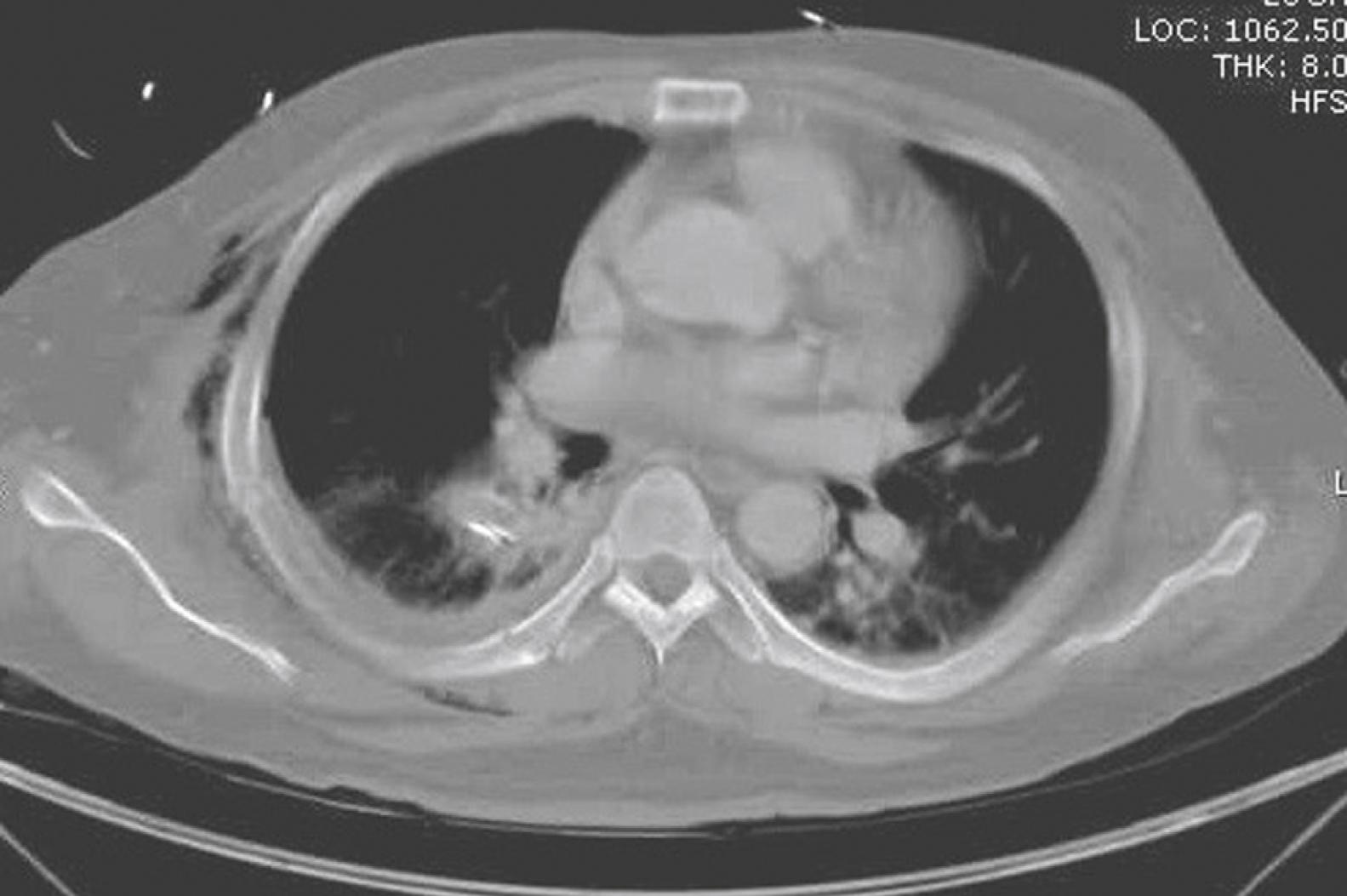
The increased frequency of CT scans for blunt trauma patients has resulted in a corresponding increase in the diagnosis of pulmonary contusions and lacerations. CT scans have been shown to detect at least twice as many pulmonary contusions as plain radiographs, and one recent study found that isolated pulmonary contusions seen on CT had a mortality of only 2.6% (compared to 4.7% for all patients with pulmonary contusion detected by plain radiography).
Chest CT scan is particularly valuable to identify a pulmonary contusion in the acute phase after injury because plain chest x-ray films have a low sensitivity. Although CT scan may not be necessary to make the diagnosis of a pulmonary contusion that is evident on plain chest radiography, it may be helpful to further define the extent of the contusion and to identify other thoracic injuries. Occult pulmonary contusions are those that are initially visible only on CT scan, not plain radiographs, and usually involve less than 20% of the lung volume. These occult pulmonary contusions are not associated with a worse clinical outcome as compared with blunt trauma patients without pulmonary contusion.
Treatment for pulmonary contusions is primarily supportive. As with flail chest, intubation and mechanical ventilation should be avoided if possible, because they are associated with an increase in morbidity, including pneumonia, sepsis, pneumothorax, hypercoagulability, and longer hospitalization. In the rare case in which one lung has been severely contused and is causing significant hypoxemia, consideration should be given to intubating and ventilating each lung separately with a dual-lumen endotracheal tube and two ventilators. This allows for the difference in compliance between the injured and the normal lung and prevents hyperexpansion of one lung and gradual collapse of the other.
Management of patients with pulmonary contusions should include the restriction of intravenous (IV) fluids (to maintain intravascular volume within strict limits) and comprehensive supportive care consisting of tracheobronchial toilet, suctioning, and pain relief. These maneuvers may preclude the need for ventilator support and allow a more selective approach to both flail chest and pulmonary contusion.
Patients sustaining the force necessary to inflict a pulmonary contusion may also have pulmonary lacerations. Most of these are minor and rarely life-threatening, and they can usually be treated with continuous oxygen therapy, observation, or tube thoracostomy. Severe lacerations are associated with hemopneumothorax, multiple displaced rib fractures, and hemoptysis. Often, these life-threatening lacerations require thoracotomy with resection or tractotomy to control bleeding.
Pneumothorax, which is the accumulation of air in the pleural space, is a common complication of chest trauma. It is reported to be present in 15% to 50% of patients who sustain significant chest trauma and is invariably present in those with transpleural penetrating injuries.
Pneumothorax can be divided into three types depending on whether air has direct access to the pleural cavity: (1) simple, (2) communicating, and (3) tension.
A pneumothorax is considered simple or closed ( Fig. 37.5 ) when there is no communication with the atmosphere or any shift of the mediastinum or hemidiaphragm resulting from the accumulation of air. Traumatic simple pneumothorax is most often caused by a fractured rib that is driven inward, lacerating the pleura. It may also occur without a fracture when the impact is delivered at full inspiration with the glottis closed, leading to a tremendous increase in intra-alveolar pressure and the subsequent rupture of the alveoli. A penetrating injury, such as a gunshot or stab wound, may also produce a simple pneumothorax if there is no free communication with the atmosphere ( Fig. 37.6 ).
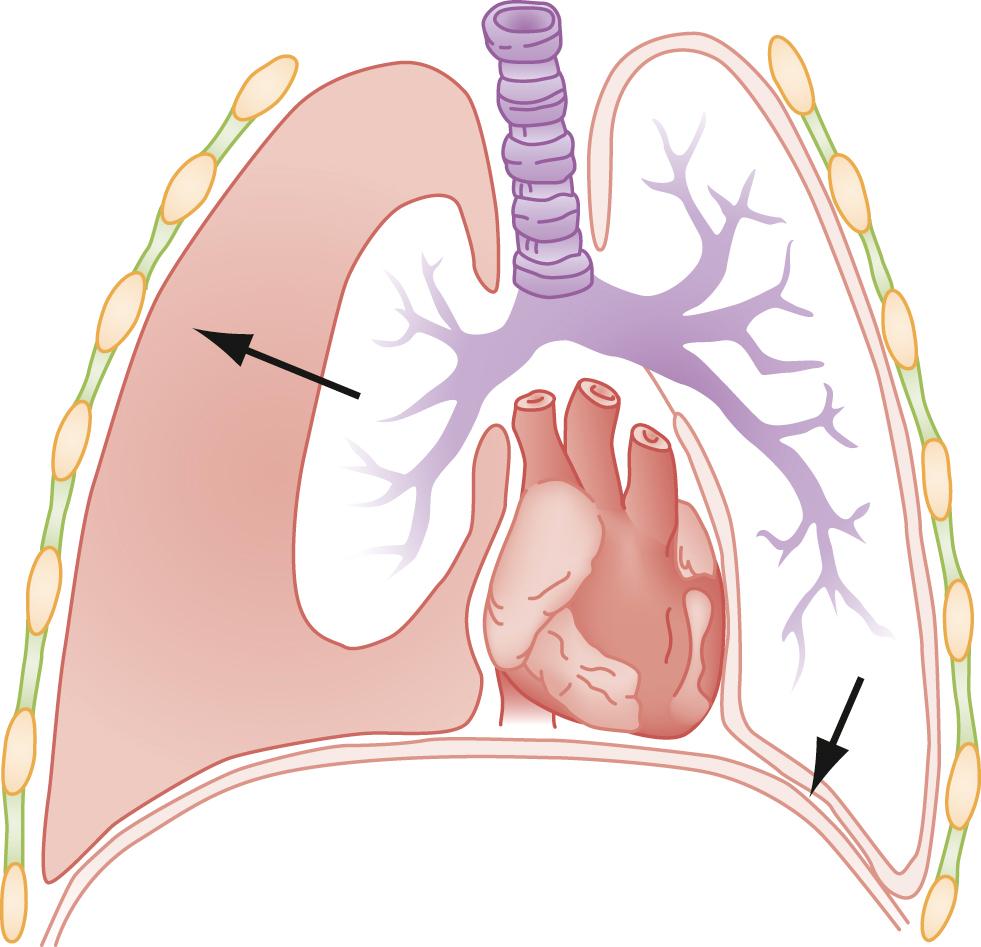
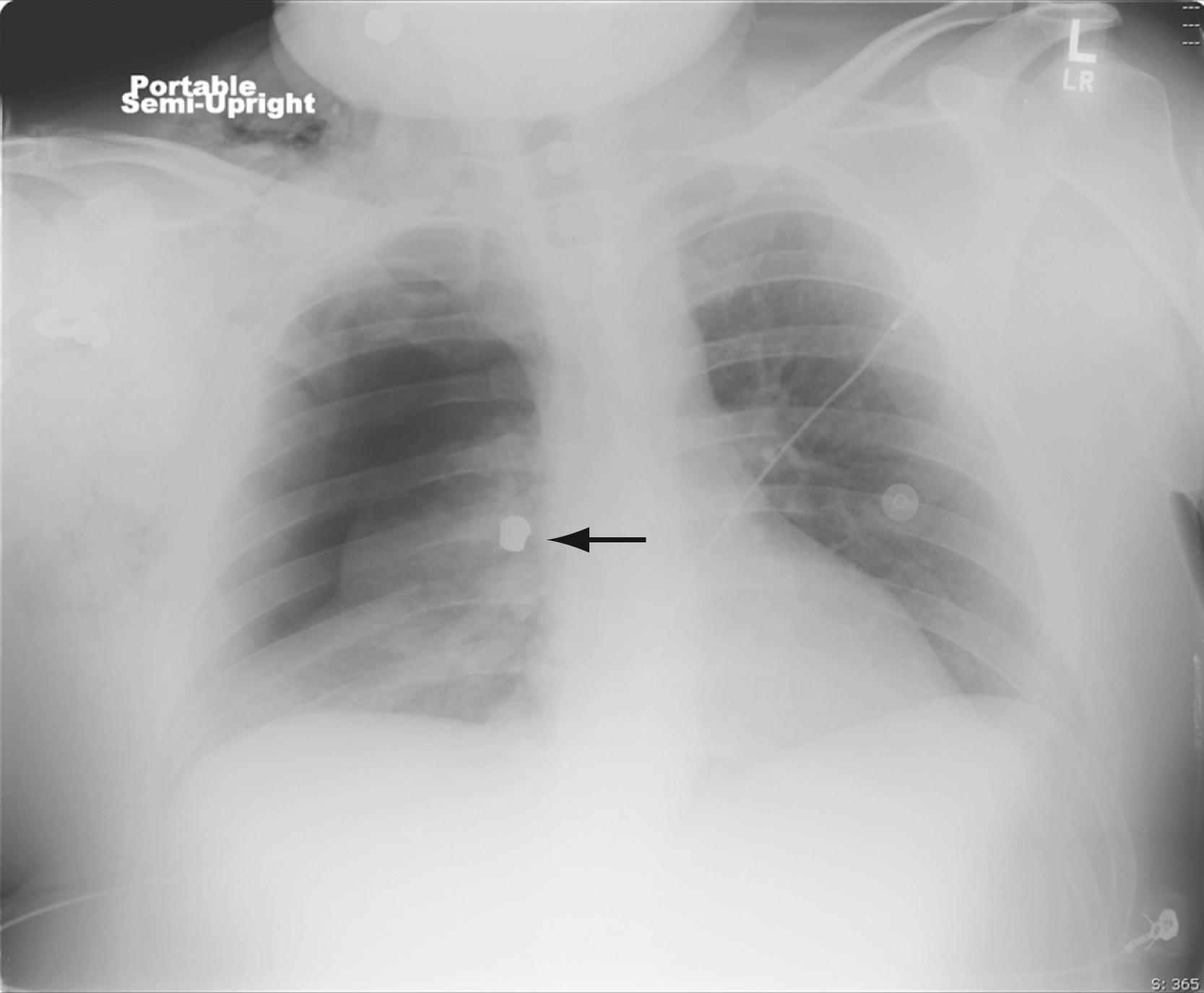
A communicating pneumothorax ( Fig. 37.7 ) is associated with a defect in the chest wall and most commonly occurs in combat injuries. In the civilian sector, this injury is typically secondary to gunshot wounds. Air can sometimes be heard flowing sonorously in and out of the defect, prompting the term “sucking chest wound.” The loss of chest wall integrity causes the involved lung to paradoxically collapse on inspiration and expand slightly on expiration, forcing air in and out of the wound. This results in a large functional dead space for the normal lung and, together with the loss of ventilation of the involved lung, produces a severe ventilatory disturbance.
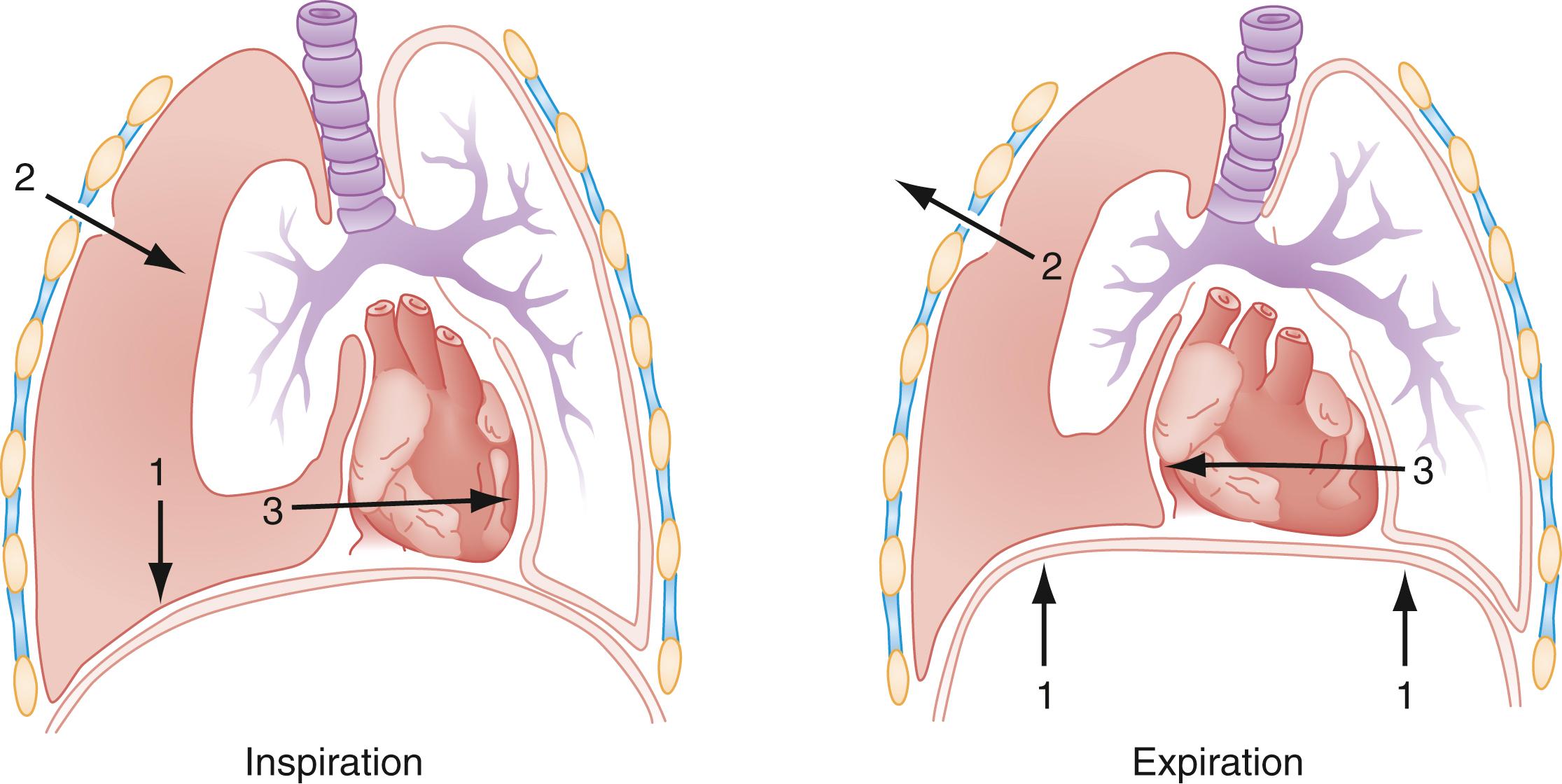
The progressive accumulation of air under pressure within the pleural cavity, with shift of the mediastinum to the opposite hemithorax and compression of the contralateral lung and great vessels, is the constellations of findings in tension pneumothorax ( Figs. 37.8 and 37.9 ). It occurs when the injury acts like a one-way valve, prevents free bilateral communication with the atmosphere, and leads to a progressive increase of intrapleural pressure. Air enters on inspiration but cannot exit with expiration. The resulting shift of mediastinal contents compresses the vena cava and distorts the cavoatrial junction, leading to decreased diastolic filling of the heart and subsequent decreased cardiac output. These changes result in the rapid onset of hypoxia, acidosis, and shock.
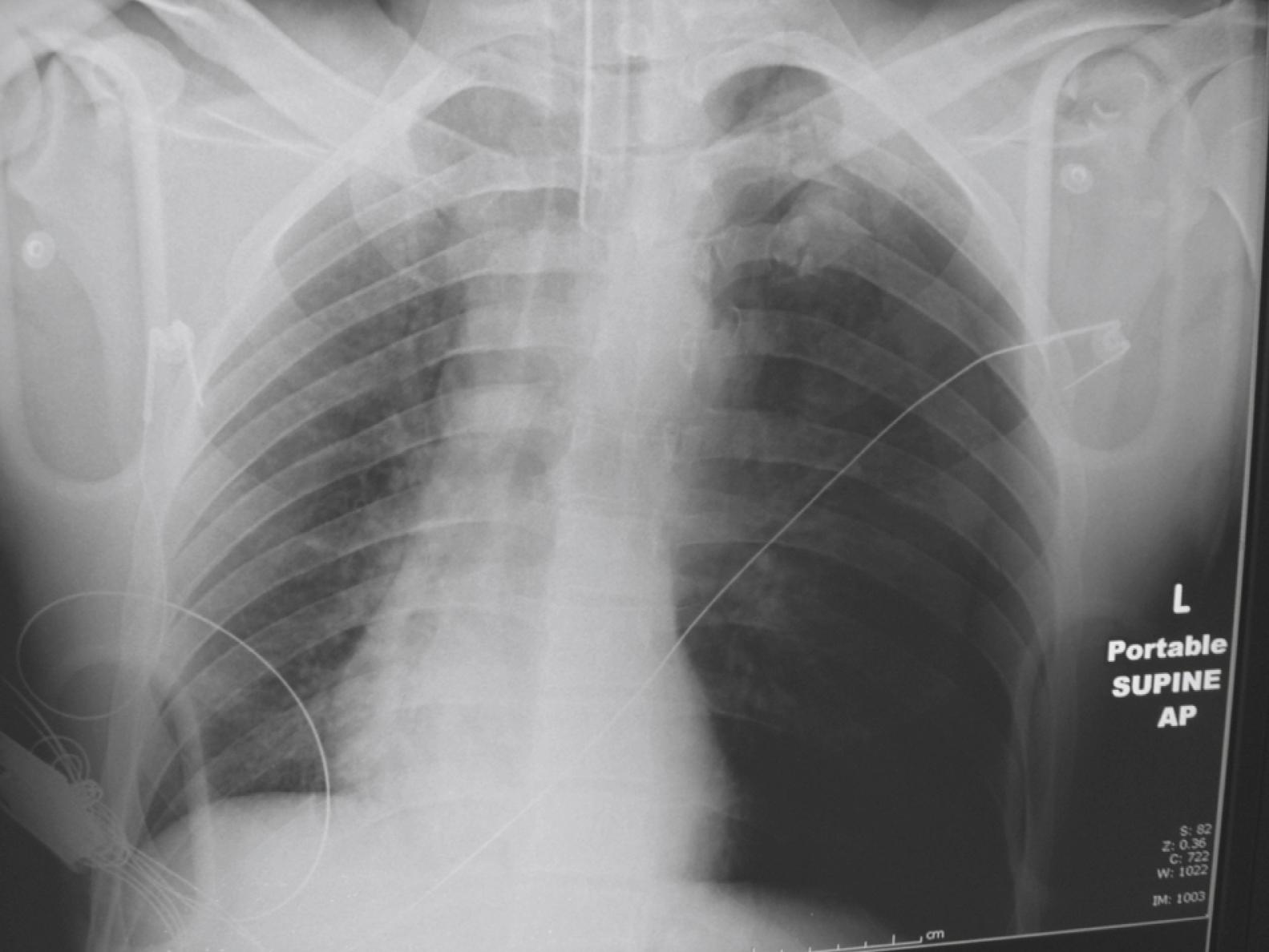
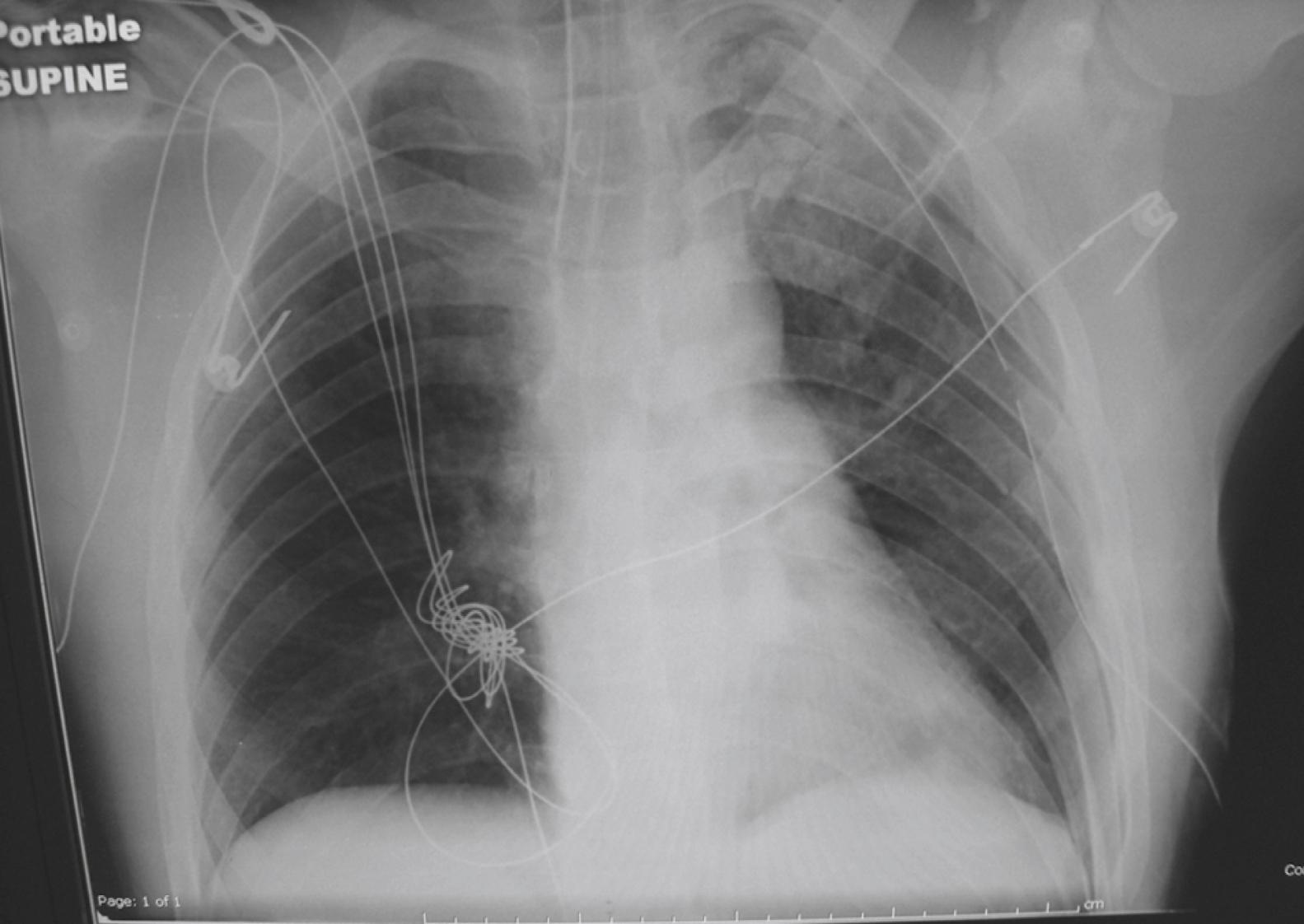
Shortness of breath and chest pain are the most common presenting complaints of pneumothorax. The patient’s appearance is highly variable, ranging from acutely ill with cyanosis and tachypnea to misleadingly healthy appearance. The signs and symptoms are not always correlated with the degree of pneumothorax. The physical examination may reveal decreased or absent breath sounds and hyper-resonance over the involved side as well as subcutaneous emphysema, but small pneumothoraces may not be detectable on physical examination.
Patients with tension pneumothorax become acutely ill within minutes and develop severe cardiovascular and respiratory distress. They are dyspneic, agitated, restless, cyanotic, tachycardic, and hypotensive and display altered mental status. The cardinal signs of tension pneumothorax are tachycardia, hypotension, oxyhemoglobin desaturation, jugular venous distention (JVD), and absent breath sounds on the ipsilateral side. However, JVD may not reliably be present with massive blood loss.
Because intrapleural air tends to collect at the apex of the lung, the initial chest radiograph should be an upright full inspiratory film if the patient’s condition permits. An upright film will often reveal small pleural effusions that are not visible on supine films, and it also allows better visualization of the mediastinum. Although the chest radiograph has traditionally been the preferred initial study for diagnosing a simple pneumothorax, several studies have found that ultrasound has greater sensitivity for pneumothorax than chest radiography. , During the e-FAST examination, pneumothorax will be detected well before chest radiography is performed. This may be particularly critical in the hypotensive poly-trauma patient with oxyhemoglobin desaturation for whom tension pneumothorax is one of the considerations as the cause of the unstable state. Suspicion of tension pneumothorax on the basis of clinical findings is indication for immediate tube thoracostomy. Treatment should not be delayed pending a confirmatory chest radiograph. Ultrasound can confirm the presence of a pneumothorax within the first minutes of the patient’s arrival, and identification of a pneumothorax in a patient with pulmonary and hemodynamic compromise is also considered confirmatory empirical evidence of tension pneumothorax requiring thoracostomy. Even without ultrasound confirmation, clinical suspicion of tension pneumothorax is justification for emergent tube thoracostomy, because delay can be detrimental.
A pneumothorax that is absent on the initial chest radiograph but is identified on subsequent chest or abdominal CT is called an occult pneumothorax. Occult pneumothorax is being diagnosed more frequently given the increased use of CT scanning ( Fig. 37.10 ).
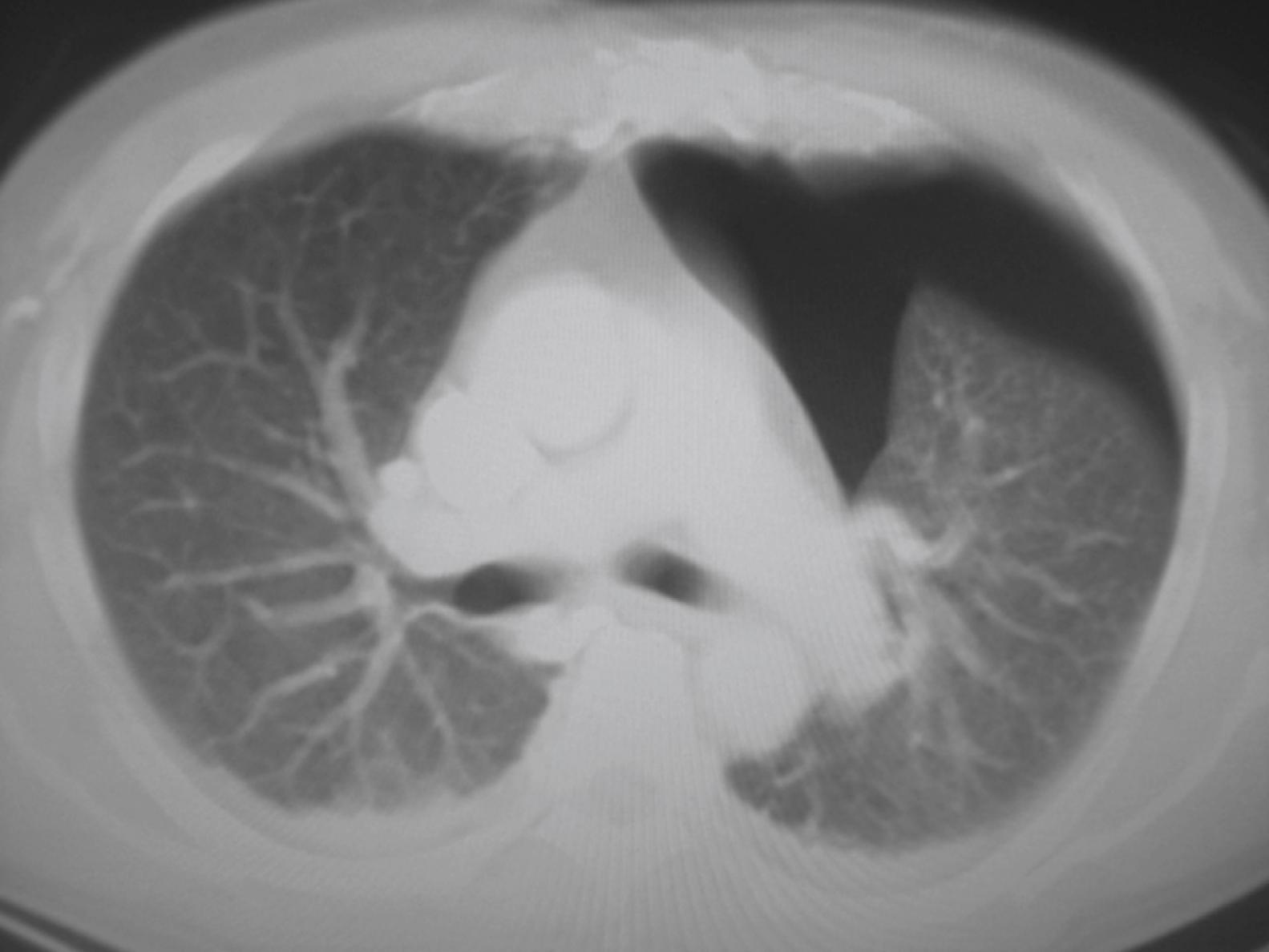
An asymptomatic patient who suffers a low-velocity penetrating trauma (typically a stab wound) and who has negative initial imaging can be safely observed, typically for 6 hours. If the initial imaging was a CT scan, the patient may be safely discharged after the period of observation. If the initial imaging was via plain radiograph, a delayed chest x-ray should be performed prior to discharge.
Treatment of a simple pneumothorax depends on its cause and size. Small, isolated apical pneumothoraces due to stab wounds may be observed without intervention. However, this conservative method seldom has application in multisystem trauma, and a chest tube should be inserted immediately upon any sign of deterioration.
Similarly, small occult pneumothoraces found only on CT scan in hemodynamically stable patients without symptoms can be managed with observation and do not need intervention, even if the patient is placed on positive-pressure ventilation.
Any moderate to large pneumothorax should be treated with a chest tube. The indications for tube thoracostomy (chest tube insertion) are listed in Box 37.2 . The preferred site for insertion is the fourth or fifth intercostal space at the midaxillary line. This lateral placement of the tube is preferred not only because it is more efficient, but also because it does not produce an easily visible cosmetic defect, compared to the anterior site at the second interspace at the midclavicular line. With multisystem trauma in which hemothorax is likely, a large chest tube (36-F to 40-F in adults and 16-F to 32-F in children) should be used. Conversely, spontaneous pneumothoraces or those due to minor or isolated injuries can be treated with smaller caliber chest tubes.
Traumatic cause of pneumothorax (except asymptomatic, apical pneumothorax)
Moderate to large pneumothorax
Respiratory symptoms regardless of size of pneumothorax
Increasing size of pneumothorax after initial conservative therapy
Recurrence of pneumothorax after removal of an initial chest tube
Patient requires ventilator support
Patient requires general anesthesia
Associated hemothorax
Bilateral pneumothorax regardless of size
Tension pneumothorax
Care is taken to be certain the vent holes along the side of the tube are all inside the chest cavity. A radiopaque line along the side of the tube with interruptions at these drainage holes helps in radiographically interpreting tube position. The tube should be attached to a water seal drainage system that allows re-expansion of the pneumothorax. If there is significant air leak or a large hemothorax, the tube may be connected to a source of constant vacuum at 20 to 30 cm H 2 O for more rapid re-expansion.
Tube thoracostomy does have some potentially serious complications, including the formation of a hemothorax, pulmonary edema, bronchopleural fistula, pleural leaks, empyema, subcutaneous emphysema, infection, intercostal artery laceration, contralateral pneumothorax, and parenchymal injury. A recent meta-analysis did not find sufficient evidence for or against the use of empirical antibiotics with all tube thoracostomy placements to prevent empyema or pneumonia, especially those needed for spontaneous pneumothoraces. However, for patients with multisystem trauma or hemothorax, the data was suggestive of a clinical benefit. We recommend routine intravenous antibiotic administration in these patients, specifically cefazolin 1 to 2 g given prior to, or within 1 hour of chest tube insertion. Vancomycin (1 g) or clindamycin (600 mg) are appropriate alternatives in patients with cephalosporin allergies.
Become a Clinical Tree membership for Full access and enjoy Unlimited articles
If you are a member. Log in here